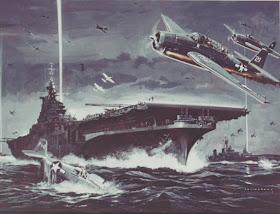 |
| Midshipman John S. McCain, 1906 |
In William F. Trimble's new biography, "Admiral John S. McCain: And the Triumph of Naval Air Power" (Naval Institute Press, 2019), we get a fascinating history of the rise of carrier-based aviation during World War II through the life of the McCain patriarch, warts and all.
Among the blemishes, "Slew" McCain's "inexplicable and inexcusable administrative and judgmental oversight" and lack of attention to detail and communication" in the aftermath of the Battle of Savo Island, according to Trimble.
Also, McCain – but more-so Halsey – was tarnished by his apparent indecision in the face of Typhoon Cobra. "Survival was the priority for many that afternoon as the wind and waves hammered the fleet, and radios crackled with one emergency call after another," Trimble writes. "McCain blundered badly."
 Nevertheless, McCain's triumphs as a warfighter and innovator make his failures small by comparison.
Nevertheless, McCain's triumphs as a warfighter and innovator make his failures small by comparison.He was considered "an airman's admiral," Trimble says. "In his typical manner, McCain boosted morale by talking to as many airmen and ground crews as he could, assuring them that he would do all he could to back them up..." He was loved by officers and enlisted Marines who admired his fighting spirit.
As Commander, Aircraft, South Pacific (ComAirSoPac) Forces, McCain was recognized for his "innovative thinking, initiative, resourcefulness and commitment, all of which are vital to operational command."
McCain practiced balanced and empowering leadership, surrounding himself with good people – never "yes-men" – and delegating responsibility to them. Key among his team was Jimmie Thach, hero of the Battle of Midway and naval aviation strategist in the Battle of the Philippine Sea.
 |
Courtesy of "Popular Mechanics" Magazine, NHHC)
|
Trimble offers this controversial assessment comparing those big battles of WWII:
"One cannot overstate the significance of the Battle of the Philippine Sea. It was a decisive victory, the great fleet engagement in the western Pacific that both adversaries had planned to fight for almost fifty years. This battle, and not Midway two years before, was the pivotal battle of the Pacific War. Neither McCain nor anyone else at the time knew that they had been part of the greatest carrier battle of all time and that there would never be another encounter of this type or scale. Nor were they aware that Japan's carriers had been effectively eliminated as a fighting force."A third huge air battle came as U.S. forces moved north from the Philippines. Trimble writes: "A savage spectacle of naval air power, the ferocious engagement over Okinawa and Formosa was comparable to the climactic moments of the Battle of Britain and the epic Battle of the Philippine Sea."
 |
| Halsey and McCain share a lighter moment and respite in 1944. |
McCain's task group, TG-38.1, was a major factor in virtually wiping out Japanese air power on Formosa and Luzon before the landings at Leyte." He received praise from Pacific Fleet commander Adm. Chester Nimitz, even as Nimitz became concerned with the physical and mental health of his senior leaders under the stress of war.
In the western Pacific, McCain and Thach developed successful strategies to counter the effects of devastating kamikaze attacks by Imperial Japan during the closing months of the war. McCain was recognized for his aggressive willingness to take risks and "brilliant tactical control of fast carrier forces."
Understandably, most of this meticulously researched book (60 pages of notes and bibliography) focuses on McCain's role during the war in key leadership positions, including as part of Halsey's 3rd Fleet as Task Force 38 commander. "McCain's Task Force 38 was the principal offensive component of Adm. W. F. Halsey's mighty Third Fleet."
 |
| Three generations of John S. McCain |
This book presents several other controversies as well as surprises, such as McCain's advocacy for recruiting women in support roles, his embrace of joint operations, his enthusiastic support for Navy public affairs, and his relationship with Adm. Marc A. Mitscher, Adm. Lockwood and other colleagues.
As Navy readers know, McCain died just days after Imperial Japan's surrender. Trimble describes the end with poignancy but barely mentions the patriarch's personal legacy as father of another Navy admiral and grandfather of a heroic POW and U.S. senator.
Adm. John S. "Slew" McCain is remembered as "a fighting admiral and a man who in the end made the ultimate sacrifice for his Navy and his country."

No comments:
Post a Comment